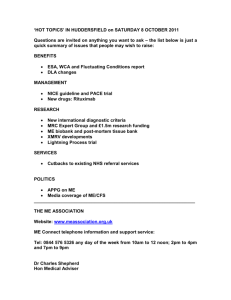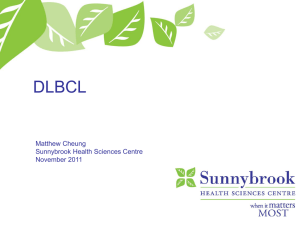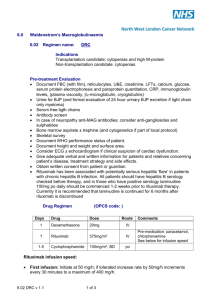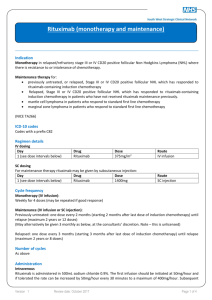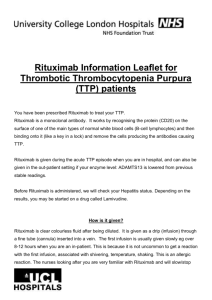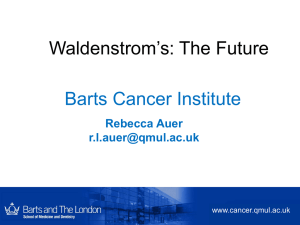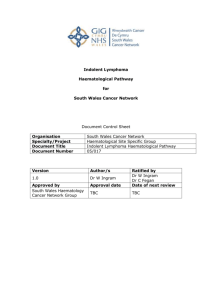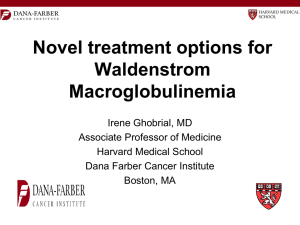Vortrag Norbert Schmitz
advertisement
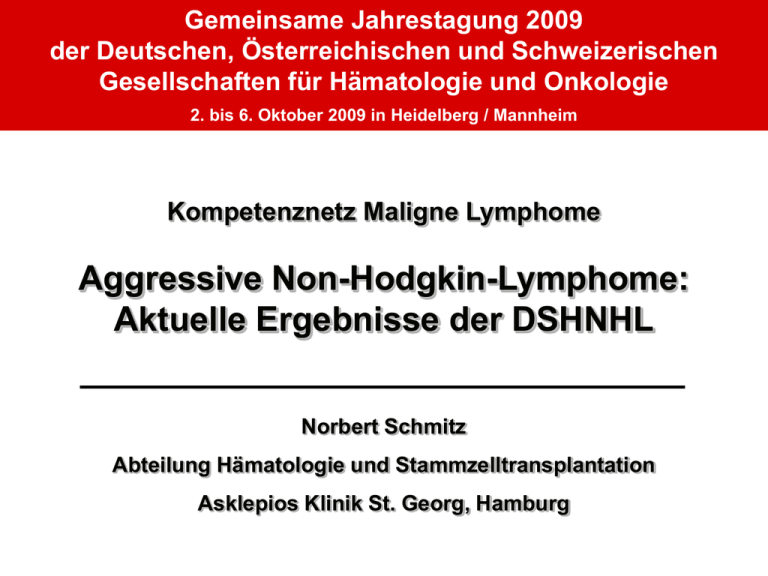
Gemeinsame Jahrestagung 2009 der Deutschen, Österreichischen und Schweizerischen Gesellschaften für Hämatologie und Onkologie 2. bis 6. Oktober 2009 in Heidelberg / Mannheim Kompetenznetz Maligne Lymphome Aggressive Non-Hodgkin-Lymphome: Aktuelle Ergebnisse der DSHNHL Norbert Schmitz Abteilung Hämatologie und Stammzelltransplantation Asklepios Klinik St. Georg, Hamburg B-NHL Derzeitige DSHNHL-Protokolle zur Primärtherapie aggressiver B-Zell-Lymphome IPI = 0 kein Bulk IPI = 1 / Bulk IPI ≥ 2 FLYER RICOVER UNFOLDER MegaCHOEP Nachfolgestudie (in Vorbereitung) Phase III ≤60 Jahre >60 Jahre FLYER (6-6/6-4) STUDY DESIGN Stage I/II aaIPI=0 no Bulk 18-60 years R C H O P C H O P C H O P C H O P C H O P C H O P R R R R R R d1 d 64 C H O P C H O P C H O P C H O P R R R R d 106 R R UNFOLDER (21/14) STUDY DESIGN + / - Radiatio Bulk / E IPI = 1 and/or Bulk R C H O P 21 C H O P 21 C H O P 21 C H O P 21 C H O P 21 C H O P 21 R R R R R R d1 C H O P 14 + / - Radiatio Bulk / E R d 75 C H O P 14 C H O P 14 C H O P 14 C H O P 14 C H O P 14 R R R R R d 105 DSHNHL 2002-1 „Mega-CHOEP“ study design after amendment 1 for CD20+ B-NHL PBSC mCHOEP I mCHOEP II mCHOEP III CYC 4500 ADR 70 VCR 2 ETO 960 PRD 500 CYC 4500 ADR 70 VCR 2 ETO 960 PRD 500 CYC 1500 ADR 70 VCR 2 ETO 600 PRD 500 1 PBSC 22 43 PBSC mCHOEP IV CYC 6000 ADR 70 VCR 2 ETO 1480 PRD 500 64 R : Rituximab 77 98 days Mega-CHOEP study (phase III) Patients 18 - 60 years, aaIPI 2,3, B-cell (CD20+), ITT (n=185) Event Free Survival (EFS) -- all patients 1 0.9 0.8 Proportion 0.7 0.6 0.5 0.4 0.3 0.2 Median observation time: 29 months 0.1 0 0 5 10 20 30 40 Months DSHNHL 23.03.09 50 60 70 Mega-CHOEP study (phase III) Patients 18 - 60 years, aaIPI 2,3, B-cell (CD20+), ITT (n=216) EFS* according to Rituximab 1 0.9 0.8 Proportion 0.7 0.6 0.5 0.4 0.3 without Rituximab (n=31) with Rituximab (n=185) 0.2 0.1 p=0.003 0 0 DSHNHL 23.03.09 5 10 20 30 40 Months 50 60 70 *event „additional R“ not counted one patient changed treatment arm to Mega-CHOEP+R after study meeting and is censored DSHNHL 2002-1 „Mega-CHOEP“ study design after amendment 1 for CD20+ B-NHL PBSC mCHOEP I mCHOEP II mCHOEP III CYC 4500 ADR 70 VCR 2 ETO 960 PRD 500 CYC 4500 ADR 70 VCR 2 ETO 960 PRD 500 CYC 1500 ADR 70 VCR 2 ETO 600 PRD 500 1 PBSC 22 43 PBSC mCHOEP IV CYC 6000 ADR 70 VCR 2 ETO 1480 PRD 500 64 R : Rituximab 77 98 days DSHNHL 2002-1 „Mega-CHOEP“ study design after the MegaCHOEP arm is closed 1 15 29 43 71 : Rituximab 99 days RICOVER-60 Study Design 6 x CHOP-14 + 30-40 Gy (Bulk, E) CD20+ DLBCL Stages I-IV 61 to 80 years Random 2x2 Factorial Design 8 x CHOP-14 + 30-40 Gy (Bulk, E) 6 x CHOP-14 + 36 Gy (Bulk, E) + 8 x Rituximab 8 x CHOP-14 + 36 Gy (Bulk, E) + 8 x Rituximab III. Elderly Patients Is further Improvement possible ? Study Design DENSE-R-CHOP-14 C H O P CD20+ DLBCL C H O P C H O P C H O P C H O P C H O P Stages I-IV 61 to 80 years 0 2 4 6 Weeks 8 10 12 14 DENSE-R-CHOP-14 RICOVER-60 (6xCHOP+8R) Progression-free Survival* IPI 1, 2 IPI 3 - 5 1 0.9 84% 0.9 0.8 83% 0.8 p=0.584 0.7 % patients % patients 1 0.6 0.5 0.4 0.3 RICOVER-60 (6xCHOP-14+8xR; n=183) 0.2 DENSE-R-CHOP-14 (6xCHOP-14+12xR; n=52) 0.1 77% 0.7 p=0.064 0.6 64% 0.5 0.4 0.3 RICOVER-60 (6xCHOP14+8xR; n=123) 0.2 DENSE-R-CHOP-14 (6xCHOP-14+12xR; n=72) 0.1 0 0 0 2 4 6 8 10 12 14 16 18 20 22 24 Months 0 2 4 6 8 10 12 14 16 18 20 22 24 Months DENSE-R-CHO/MP-60 UNFAVORABLE Study Design R-CHOP-14 + 36 Gy IN-RT* CD20+ DLBCL IPI 2-4 IPI 1 Bulky 61 to 80 years Random 2x2 Factorial Design DENSE-R-CHOP-14 +36 Gy IN-RT* R-CHMP-14 + 36 Gy IN-RT* * Except Interim-PET-neg. DENSE-R-CHMP-14 + 36 Gy IN-RT* Involvement of CNS in aggressive NHL risk factors and prophylaxis Norbert Schmitz, Volkmar Boehme, Samira Zeynalova, Markus Loeffler and Michael Pfreundschuh GERMAN HIGH-GRADE NHL STUDY GROUP (DSHNHL) Risk-factors for CNS events in the RICOVER-60 trial multivariate analysis all patients risk factor RR 95% CI p - value > 1 extranodal sites 3.4 (2.0; 5.8) < 0.001 B-symptoms 1.9 (1.1; 3.3) 0.025 LDH > UNV 1.5 (0.9; 2.7) 0.146 risk factor RR 95% CI p - value > 1 extranodal sites 2.0 (0.8; 4.9) 0.134 ECOG > 1 2.8 (1.1; 7.0) 0.025 LDH > UNV 3.9 (1.3; 11.9) 0.018 R-treated patients only CNS events in the RICOVER-60 trial "high-risk" patients with LDH > N, >1 E-lesion, B-symptoms / ECOG >1 all patients ( ) / only patients with R-CHOP-14 ( ) 0.40 0.35 proportion of patients 0.30 "high-risk" patients 0.25 0.20 0.15 0.10 p<0.001 all other patients 0.05 0.00 0 10 20 30 40 months 50 60 70 80 CNS prophylaxis In the RICOVER-60 trial MTX 15mg i.th. 1 d1 5 15 d15 20 d29 d43 d57 d71 d85 d99 d43 d57 d71 d85 d99 In future trials MTX 15mg i.th. d1 d15 d29 2 weeks after last chemo 2 MTX 1.5mg/m² i.v. T-NHL DSHNHL 2006-1B Primärtherapie für PTCL bei älteren Patienten (>60 J.) A C 30 H mg O A C 30 H mg O A C 30 H mg O A C 30 H mg O A C 30 H mg O A C 30 H mg O P P P P P P C H O P C H O P C H O P C H O P C H O P C H O P n=150 R A = Alemtuzumab n=150 T-cell lymphomas in DSHNHL trials Results from the NHL-B1 trial (≤ 60 years, LDH ≤ N, n=98) Event-free survival: role of etoposide 1 0.9 0.8 6x CHOEP-14/21 (n=52) 0.7 Proportion 0.6 0.5 0.4 0.3 6x CHOP-14/21 (n=46) 0.2 p=0.010 0.1 0 0 10 20 30 40 50 60 Months 3-years EFS-rate: DSHNHL 70 80 90 100 110 with Etoposide: without Etoposide: 70.6% (95% CI: 58.1-83.1%) 49.8% (95% CI: 35.3-64.3%) HDT / ASCT in T cell lymphoma as part of primary treatment Prospective Phase II Trials n Median age Regimen ASCT (%) CR / PR pre Tx TRM OS EFS /FFS/ PFS Follow-up Corradini Lopez-Guillermo Reimer D`Amore (Leukemia 2006) (ASH 2006, #3070) (JCO 2009) (EHA 2009 #1082) 62 41 83 166 (incl.19 ALK+ ALCL) (no ALK+ ALCL) (no ALK+ ALCL) (no ALK+ ALCL) 43y 47y 47y 57y 1) 2xAPO>2xDHAP HD Mito./Mel 2) MACOP-B>HD AraC/Mito BEAM 3xmaxiCHOP + 3xESHAP altern. 4-6xCHOP-21 + DexaBEAM HD Cy + TBI 6xCHOEP-14 BEAM 74% 41% 66% 70% 56% / 16% 49% / 10% 39% / 40% 50% / 35% 4.8% 3% 3.6% (4%) 34% (12y) [21%*] 39% (4y) 48%+ (3y) 57% (3y) 30% (12y) 18%* 30% (4y) PFS: 36% PFS: 48% 76mo 3.9yrs (survivors) 33 mos med. 3.75 yrs [* Non ALK+ ALCL] [+ CR patients only] allo SCT in pTCL HLA-id donors (n=74) Overall Survival and Progression free survival 0,80 0,80 0,60 0,60 PFS 1,00 OS 1,00 43% 0,40 0,40 0,20 0,20 0,00 0 12 24 36 48 60 72 Months after SCT 84 96 108 39% 0,00 0 12 24 36 48 60 72 84 96 108 Months after SCT The European Group for Blood and Marrow Transplantation The European Group for Blood and Marrow Transplantation The European Group for Blood and Marrow Transplantation DSHNHL 2006-1A: Studiendesign B-NHL Rezidivtherapie CORAL Trial of RICE v DHAP Which salvage regimen is the best? R A N → D CD20+ DLBCL O Relapsed/Refractory M I Z E SD/POD → Off R-ICE x 3 AB SE CA TM R-DHAP x 3 R A Rx6 N D PR/CR → O M I Z Obs E N=400 Place of immunotherapy post transplantation? Orlando ASCO May 2009 / Coral study C. Gisselbrecht 64% N=160 31% N=228 PROGRESSION-FREE SURVIVAL ACCORDING TO FAILURE FROM DIAGNOSIS (INDUCTION ITT) 62% N=147 30% N=241 PROGRESSION-FREE SURVIVAL ACCORDING TO PRIOR RITUXIMAB (INDUCTION ITT) Orlando ASCO May 2009 / Coral study C. Gisselbrecht Aggressive B-NHL – Rezidive Ergebnisse der allogenen SCT – DSHNHL R3 aNHL, 18-65 y, refractory disease, early relapse HR, relapse after ASCT alloPBSC MRD MUD MMF Tacrolimus F F F F F 25 25 25 25 25 R-ICE R-ICE C C 60 60 R B 4 B 4 B 4 MMF R R R R Tacrolimus 375 375 375 375 w-8 w-5 d-9 d-8 d-7 d-6 d-5 d-4 d-3 w3 w4 w5 w6 R R R R 375 375 375 375 w25 w26 w27 B. Glass Glass et al , Blood 110: ASH abstract #3043 w28 Aggressive B-NHL - Rezidive Ergebnisse der allogenen SCT – DSHNHL R3 Progression Free Survival, n=81 DSHNHL 1.0 Probability of PFS 0.9 0.8 0.7 0.6 0.5 0.4 0.3 0.2 0.1 0.0 0.0 0.5 1.0 1.5 2.0 2.5 3.0 3.5 4.0 Time after Transplant (Years) Glass et al. 4.5 5.0 5.5 6.0 Future developments • The addition of Rituximab to conventional chemotherapy (and high-dose chemotherapy?) has significantly improved first-line treatment results of young, high-risk patients with DLBCL. • Increasingly less patients will show chemo-sensitive disease after relapse from R-chemotherapy. Results of autografting will deteriorate. Allogeneic transplantation needs further study. BACKUP RICOVER-60 - Event-free Survival 1 0.9 0.8 6x R-CHOP 14 Proportion 0.7 8x R-CHOP 14 3-year rates: 0.6 8x CHOP 14 0.5 66.5% 63.1% 1: 6 x CHOP 14 (n=307) 2: 8 x CHOP 14 (n=305) 3: 6 x R-CHOP 14 (n=306) 4: 8 x R-CHOP 14 (n=304) 0.4 0.3 0.2 0.1 53.0% 47.2% 1, 2: p=0.037 1, 3: p<0.001 1, 4: p<0.001 3, 4: p=0.561 6x CHOP 14 50 70 0 0 10 20 30 40 60 80 Months Pfreundschuh et al., Lancet Oncol. (2008) Perspectives of anti-B Cell Antibodies • Optimization of rituximab • Dose-dense rituximab • Combination with IL-21 • 2nd- / 3rd-generation anti-CD20 antibodies • Ofatumomoab • GA 101 • anti-CD19 • anti-CD40 (SGN-40) • anti-CD80 • Radioimmunotherapy • CD20: 90Y-ibritumomab tiuxetan (#8565) • CD22: 90Y-epratumomab (#8502) • Bispecific anti-CD19 antibodies Rituximab Schedules for Elderly Patients with DLBCL GELA (8 x R) ECOG (5 x R) DSHNHL (8 x R) C H O P C H O P C H O P C H O P C H O P C H O P C H O P C H O P 24 C H O P C H O P C H O P C H O P C H O P C H O P C H O P C H O P 24 C H O P C H O P C H O P C H O P C H O P C H O P 12 DLBCL at ASH 2008 Novel therapies for (relapsed DLBCL): - Lenalidomide : - ORR 29% (21/73); CR 4% - mTor Inhibitors (Temsirolimus, Everolimus) - ORR 35% ; CR 5% - Fostamatinib (oral Syk-Inhibitor; # 3): - ORR 23% (5/23), CR 5% - preclinical: - IL-21 (# 601) - PU-H71 (purine-scaffold Hsp 90 inhibitor; # 602) - LBH589 (HDAC inhibitor; # 603) - Obatoclax (BH3-mimetic; #605) - MLN4924 (s.-molec. Inhibitor of Nedd8; #606) RICOVER-60 Trial 61- 80 years, CD20+ B-cell, with Rituximab (n=610) by IPI score PFS OS 1 1 11 0.9 0.9 0.9 0.9 0.9 0.9 0.8 0.8 0.8 0.8 0.8 0.8 0.7 0.7 0.7 0.7 0.6 0.6 p=0.032 0.5 0.5 p=0.219 0.4 0.4 0.4 0.4 0.3 0.3 0.2 0.2 0.1 0.1 0.3 0.3 0.2 0.2 p<0.001 0.2 0.2 p<0.001 0.1 0.1 0 10 10 20 20 30 30 40 40 50 50 60 60 70 70 80 80 p<0.001 0.1 0.1 0 0 0 p=0.161 0.5 0.5 p=0.249 0.4 0.4 0.3 0.3 p=0.021 0.6 0.6 p=0.036 0.5 0.5 p=0.005 0.7 0.7 Proportion 0.6 0.6 p<0.001 Proportion p=0.002 Proportion Proportion EFS 00 0 0 10 10 20 20 30 30 40 40 50 50 60 60 70 70 80 80 0 0 10 10 20 20 30 30 40 40 Months Months Months Months Months Months IPI 1: 184 (30%); IPI 2: 172 (28%); IPI 3: 155 (26%); 50 50 60 60 70 70 IPI 4, 5: 99 (16%) 80 80
